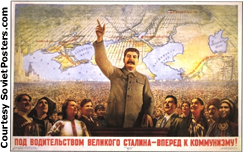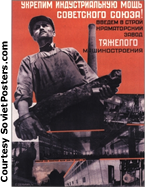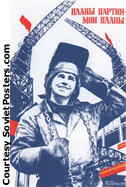Lesson Three: The Soviet Union Under Stalin
2. Lesson
Stalin's economic ideology centred on control and regulation. His economic plan was a total rejection of Lenin's partly liberalist New Economic Policy (NEP). Instead, Stalin imposed a centrally-planned economy with
-
nationalization of most of the means of production
-
five-year plans
-
rapid industrialization
-
collectivization of agriculture
-
controlled distribution of wealth
Watch this brief video on a how a centrally planned or command economy works.

Centrally Planned Economy
Let's see what it looked like under Joseph Stalin
Nationalization of Most of the Means of Production

Under the leadership of the great Stalin
- forward to communism!
All natural resources and large-scale heavy
industries and stores were nationalized. Heavy
industries such as mines, oil production, steel
production, heavy machinery, forestry mills, railroads,
and factories of all kinds belonged to "the people",
which really meant Stalin's government. No individual
businessman could own large scale industries. The
government controlled them and appointed managers
to run them. No one could make a private profit from
the nation's resources, and it was illegal to hire workers
privately. However, small businesses such as shoe
repair were allowed as long as they did not employ
workers other than the owner.
Rapid Industrialization

Let's make Soviet industrial power stronger!
Compared to much of the industrialized world, the Soviet Union was industrially backward with most of its economy based on agriculture. Therefore, rapid industrialization of the Soviet Union was high on Stalin's economic agenda. In the first five-year plan from 1928 to 1932, almost all Soviet investment went into heavy industry. Stalin saw heavy industry as the key to industrial power.
Thus, Stalin believed that before factories could produce goods, the factories had to be built, equipped, and powered. Therefore, primary emphasis was placed on energy supplies, construction materials, and machine tools. Each of the heavy industries of coal, iron, steel, and oil had extremely high production targets set for them. Production increased, many new factories were built, and targets were achieved ahead of time. Future five-year plans continued to emphasize heavy industry at the expense of individual consumer goods.

Plans of the Party - My Plans!
The goal of Stalin's economic five-year plans was to expand industry and collectivize agriculture. The whole economy was to be run like one big company with Stalin at the head. Production goals were determined and quotas (a certain predetermined amount) were set. Then, Gosplan, the central government planning agency, planned for the production of every item. Gosplan collected information from other government agencies and coordinated all the decision-making. Gosplan's job was to ensure a continuous supply of raw materials and to keep paths of distribution efficient. Under Stalin, production targets were often unreasonable and nearly impossible to meet. But through the use of force, progress was made.
Collectivization of Agriculture

We will get a rich harvest from the soil!
Privately-owned farms were collectivized by the government and combined to form large state-owned farms. Ninety-seven percent of the farmland became government owned. Small private plots (perhaps an acre each) made up the other 3%. Farm workers in the Soviet Union worked on immense government-owned farms with from 500 to 700 workers each.
In 1929, when Stalin declared that all farms were to be collectivized, the kulaks (private farmers) in Ukraine rebelled by poisoning their wells, killing their livestock, and destroying their crops. Stalin reacted with ruthless force. As many as five million kulaks who resisted collectivization were either executed or sent to prison camps in remote Siberia. Millions more starved from the famine that resulted, and recovery of Soviet agriculture took many years.
Controlled Distribution of Wealth
Soviet central planners answered the economic question of "For whom to produce?" Standards of living in the USSR lagged behind those in capitalist countries for two reasons:
- Economic Equality: Salaries were determined by the central government. All workers were paid about the same amount, depending on family size. Doctors made the same amount of money as industrial workers. However, because of the emphasis on heavy industry, bonuses were paid to industrial workers if they met or surpassed production targets. Still, the amount of pay was low in comparison to workers in capitalist countries. For the most part, if a person worked harder than others, he or she was not rewarded with more money. As a result, individual incentive to work hard was low, which affected production.
- Emphasis on Heavy Industry: Central planning concentrated on heavy industry rather than consumer goods. Products such as cars, TVs, fridges, stoves, clothing, and other personal products received low priority and were often difficult to obtain. Basic necessities such as food, clothing, and shelter were supplied at low prices when they were available. Prices were fixed by central planning. Anything beyond the basic necessities was considered luxury and was not produced. Housing was usually in the form of apartments; no private property meant not owning one's own home. Clothing was usually drab and meant to be useful not colourful and fashionable.